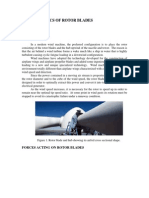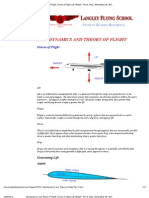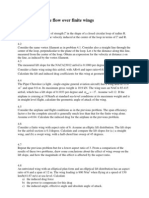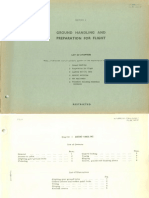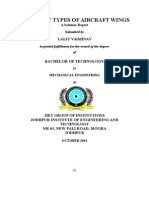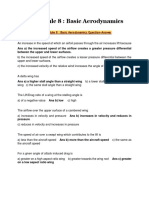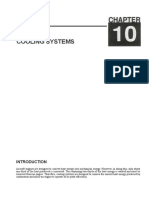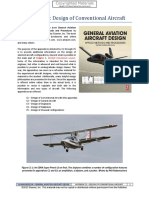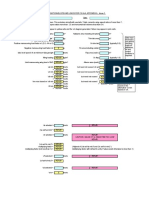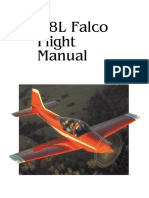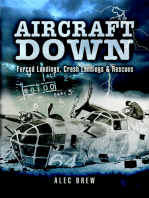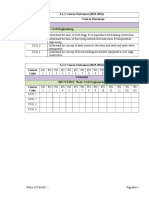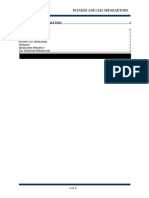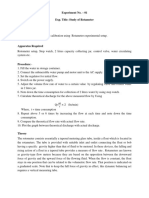Aerodynamics Seminar
Aerodynamics Seminar
Uploaded by
AbhishekDangiCopyright:
Available Formats
Aerodynamics Seminar
Aerodynamics Seminar
Uploaded by
AbhishekDangiOriginal Description:
Original Title
Copyright
Available Formats
Share this document
Did you find this document useful?
Is this content inappropriate?
Copyright:
Available Formats
Aerodynamics Seminar
Aerodynamics Seminar
Uploaded by
AbhishekDangiCopyright:
Available Formats
DATE-8 FEB 13
Aerodynamics
How do those things really fly?
ABHISHEK DANGI
ROLL NO.
1006447001
Airbus 380
An aerodynamics challenge
FA-18 Condensation Pattern
Aerodynamics involves multiple flow regimes
Legacy Aircraft
Aerodynamics is a maturing science
Outline
Terms and Definitions
Forces Acting on Airplane
Lift
Drag
Concluding remarks
Terms and Nomenclature
Airfoil
Angle of attack
Angle of incidence
Aspect Ratio
Boundary Layer
Camber
Chord
Mean camber line
Pressure coefficient
Leading edge
Relative wind
Reynolds Number
Thickness
Trailing edge
Wing platform
Wingspan
Force Diagram
Airfoil Definitions
Definition of Lift, Drag & Moment
L = 1/2 V
2
C
L
S
D = 1/2 V
2
C
D
S
M = 1/2 V
2
C
M
S c
A Misconception
A fluid element that splits at the leading edge and
travels over and under the airfoil will meet at the
trailing edge.
The distance traveled over the top is greater than over the
bottom.
It must therefore travel faster over the top to meet at the
trailing edge.
According to Bernoullis equation, the pressure is lower on
the top than on the bottom.
Hence, lift is produced.
How Lift is Produced
Continuity equation
Bernoullis equation
Pressure differential
Lift is produced
The Truth
A fluid element moving over the top surface leaves
the trailing edge long before the fluid element
moving over the bottom surface reaches the
trailing edge.
The two elements do not meet at the trailing edge.
This result has been validated both experimentally
and computationally.
Airfoil Lift Curve (c
l
vs. o)
Lift Curve - Cambered &
Symmetric Airfoils
Slow Flight and Steep Turns
L = 1/2 V
2
C
L
S
Outcome versus Action
Slow Flight
Lift equals weight
Velocity is decreased
C
L
must increase
o must be increased on the lift curve
Velocity can be reduced until C
L
max
is
reached
Beyond that, a stall results
Slow Flight and Steep Turns
L = 1/2 V
2
C
L
S
Outcome versus Action
(Concluded)
Steep Turns (Bank, yank and crank)
Lift vector is rotated inward (bank) by the bank
angle reducing the vertical component of lift
Lift equals weight divided by cosine |
Either V (crank), C
L
or both must be increased to
replenish lift
To increase C
L
, increase o (yank) on the lift curve
To increase V, give it some gas
More effective since lift is proportional to the velocity
squared
Stalling Airfoil
Effect of Bank Angle on Stall
Speed
L = 1/2 V
2
C
L
S
| equals the bank angle
At stall C
L
equals C
Lmax
L = W / cos |
Thus
V
stall
= [2 W / ( C
L max
S cos |)]
1/2
Airplane thus stalls at a higher speed
Load factor increases in a bank
Thus as load factor increases, V
stall
increases
This is whats taught in the Pilots Handbook
Surface Oil Flow - Grumman Yankee
o = 4
0
,
11
0
, &
24
0
Drag of an Airfoil
D = D
f
+ D
p
+ D
w
D = total drag on airfoil
D
f
= skin friction drag
D
p
= pressure drag due to
flow separation
D
w
= wave drag (for transonic
and supersonic flows)
Skin Friction Drag
The flow at the surface of the airfoil adheres to
the surface (no-slip condition)
A boundary layer is created-a thin viscous
region near the airfoil surface
Friction of the air at the surface creates a
shear stress
The velocity profile in the boundary layer goes
from zero at the wall to 99% of the free-
stream value
t = (dV/dy)
wall
is the dynamic viscosity of air [3.73 (10)
-7
sl/f/s]
The Boundary Layer
Two types of viscous flows
Laminar
Streamlines are smooth and regular
Fluid element moves smoothly along streamline
Produces less drag
Turbulent
Streamlines break up
Fluid element moves in a random, irregular and
tortuous fashion
Produces more drag
t
w laminar
< t
w turbulent
Reynolds Number
Re
x
= V
x /
Ratio of inertia to viscous forces
Boundary Layer Thickness
(Flat Plate)
Laminar Flow
o = 5 x / R
ex
1/2
Turbulent Flow
o = 0.16 x / R
ex
1/7
Turbulent Flow-Tripped B.L.
o = 0.37 x / R
ex
1/5
Example: Chord = 5 f, V
= 150 MPH, Sea
Level
R
ex
= 6,962,025
o = 0.114 inches Laminar B.L.
o = 1.011 inches Turbulent B.L.
o = 7.049 inches Tripped Turbulent B.L.
Infinite vs. Finite Wings
Finite Wings
The Origin of Downwash
The Origin of Induced Drag
D
i
= L sin o
i
Elliptical Lift Distribution
C
D,I
= C
L
2
/ (te AR)
Change in Lift Curve Slope
for Finite Wings
Ground Effect
Occurs during landing and takeoff
Gives a feeling of floating or riding on a
cushion of air between wing and ground
In fact, there is no cushion of air
Its effect is to increase the lift of the wing and
reduce the induced drag
The ground diminishes the strength of the wing
tip vortices and reduces the amount of
downwash
The effective angle of attack is increased and
lift increases
Ground Effect
(Concluded)
Mathematically Speaking
L = 1/2
2
S C
L
An increased angle of attack, increases C
L
Hence L is increased
D = 1/2
2
S [C
D,0
+ | C
L
2
/(t e AR)]
C
D,0
is the zero lift drag (parasite)
| C
L
2
/(t e AR) is the induced drag
e is the span efficiency factor
| = (16 h / b)
2
/ [1 + (16 h / b)
2
]
b is the wingspan
h is the height of the wing above the ground
Wing Dihedral (I)
Wings are bent upward
through an angle I, called
the dihedral angle
Dihedral provides lateral
stability, i.e., an airplane in
a bank will return to its
equilibrium position
This is a result of the lift on
the higher wing being less
than the lift on the lower
wing providing a restoring
rolling moment
Drag of a Finite Wing
D = D
f
+ D
p
+ D
w
+ D
i
D = total drag on wing
D
f
= skin friction drag
D
p
= pressure drag due to
flow separation
D
w
= wave drag (for transonic
and supersonic flows)
D
i
= Induced drag (drag due to
lift)
Drag of a Wing
(Continued)
Induced drag - drag due to
lift
Parasite drag - drag due to
non-lifting surfaces
Profile drag
Skin friction
Pressure drag (Form drag)
Interference drag (e.g., wing-
fuselage, wing-pylon)
Flaps
A Mechanism for High Lift
Effect of Flaps on Lift Curve
High Lift Devices
1. No flap
2. Plain flap
3. Split flap
4. L. E. slat
5. Single slotted flap
6. Double-slotted flap
7. Double-slotted flap
with slat
8. Double-slotted flap
with slat and
boundary layer
suction
9. Not shown - Fowler
flap
Shape Comparison
Modern vs. Conventional Airfoils
Maximum Lift Coefficient Comparison
Modern vs. Conventional Airfoils
Whats Next on the Agenda
Boeing 787 Dreamliner
Boeing 787
Whats Next on the Agenda
Boeing Blended Wing-Body Configuration
Boeing 797
Concluding Remarks
What was not discussed
Transonic flow
Drag-divergence Mach number
Supersonic flow
Wave drag
Swept wings
Compressibility effects
Boundary layer theory
The history of aerodynamics
Airbus 380 Interior
Good aerodynamics results in improved creature comforts
Winglets
Reduced induced drag
Equivalent to extending
wingspan 1/2 of winglet
height
Less wing bending moment
and less wing weight than
extending wing
Hinders spanwise flow and
pressure drop at the wing
tip
Looks modern/esthetically
pleasing
Boeing 737 Winglet
HondaJet
HondaJet
Engine Position
The Sweet Spot
Location where the engine coexists with the wing
and enjoys favorable interference effects
The reason - Transonic Area Rule
Richard Whitcomb - NASA Scientist
The total cross-sectional area must vary smoothly
from the nose to tail to minimize the wave drag
Wave drag is created by shock waves that appear
over the aircraft as a result of local regions of
embedded supersonic flow
HondaJet Aerodynamics
Engine inlet is positioned at 75% chord
As the cross-sectional area decreases at the trailing
edge of the wing, the engine adds area thus
yielding a smooth area variation
This engine position also slows the flow and
decreases the wing-shock strength
The critical Mach number is thus increased from
.70 to .73
The pylon is positioned near the outer portion of
the nacelle and cambered inward to follow the flow
direction
During stall, separation starts outboard of the
pylon; separation does not occur between the
pylon and fuselage
HondaJet
Aerodynamics
(Continued)
Natural laminar flow fuselage nose
Following the area rule, the nose expands
from its tip and then contracts as the
windshield emerges.
As the wing is approached, the fuselage
cross-sectional area increases smoothly;
this helps maintain the laminar flow
HondaJet
Aerodynamics
(Concluded)
Natural laminar flow wing
Utilizes integral, machined panels that
minimizes the number of parts for smoother
flow when mated together
Employs winglets to reduce induced drag
30% more efficient than other business jets
Eagle in Flight
Winglets
Elastic Flaps
Minimized Noise
& Detectability
Variable
Camber
Retractable Landing Gear
STOL/VTOL
Capabilities
Smart Structures
Tilting
Control
Center Smooth
Fairings
Variable
Twist
Adaptive
Dihedral
Turbulator
Tail ?
b/2
c
c
d,i
= c
l
2
/
AR
c
l
= 2 L/
V
2
S
Questions and Answers
You might also like
- Steady Aircraft Flight and PerformanceFrom EverandSteady Aircraft Flight and PerformanceRating: 5 out of 5 stars5/5 (2)
- Ducted Prop For STOL PaperDocument8 pagesDucted Prop For STOL PaperLEADANo ratings yet
- QuizDocument2 pagesQuizSandeep NrynNo ratings yet
- AE4011 Final Report (LHT-4)Document127 pagesAE4011 Final Report (LHT-4)Tan ZhenyangNo ratings yet
- Aeorodynamics of Rotor BladesDocument23 pagesAeorodynamics of Rotor BladesAshley_RulzzzzzzzNo ratings yet
- Types of DragDocument3 pagesTypes of DragSwetha SharmaNo ratings yet
- Aerodynamics and Theory of Flight, Forces of Flight, Lift, Weight, Thrust, DragDocument14 pagesAerodynamics and Theory of Flight, Forces of Flight, Lift, Weight, Thrust, DragMohammad ChessterNo ratings yet
- F-22 Plans 22wsDocument8 pagesF-22 Plans 22wsJosephRomeraloNo ratings yet
- Module 11.1 - B1 - Rev 00 PDFDocument194 pagesModule 11.1 - B1 - Rev 00 PDFAhmed Aman IbrahimNo ratings yet
- Annular Wing CraftDocument2 pagesAnnular Wing CraftCalvin NgNo ratings yet
- Wing Theory Exercise PDFDocument10 pagesWing Theory Exercise PDFthanesh01100% (2)
- T11, Section 2, Ground HandlingDocument52 pagesT11, Section 2, Ground HandlingDavid WongNo ratings yet
- FM 1-514 Principles of Helicopter FlightDocument59 pagesFM 1-514 Principles of Helicopter Flightwawaland100% (1)
- McDonnell USAF Datcom 1979 Volume 1 User ManualDocument313 pagesMcDonnell USAF Datcom 1979 Volume 1 User ManualFabian ZenderNo ratings yet
- Subsonic Flow CharacteristicsDocument12 pagesSubsonic Flow Characteristicsykhamidi3889No ratings yet
- Propeller TheoryDocument15 pagesPropeller TheoryDexterydNo ratings yet
- Neral Capítulo.1 PDFDocument8 pagesNeral Capítulo.1 PDFemhidalgoNo ratings yet
- INTRODUCTION Generation of LiftDocument9 pagesINTRODUCTION Generation of LiftMadjidi NoerNo ratings yet
- Different Types of Aircraft WingsDocument32 pagesDifferent Types of Aircraft Wingslalit vaishnav100% (1)
- Aircraft Design With Active Load Alleviation and Natural Laminar FlowDocument36 pagesAircraft Design With Active Load Alleviation and Natural Laminar Flowjiaxu825No ratings yet
- Land GearDocument18 pagesLand Geardatav44No ratings yet
- Aerodynamics MCQDocument42 pagesAerodynamics MCQchhetribharat08No ratings yet
- Deep StallDocument10 pagesDeep StallGurmaan SinghNo ratings yet
- Drag Reduction in An AirplaneDocument14 pagesDrag Reduction in An AirplaneDhruvNo ratings yet
- Components Weight EstimatingDocument19 pagesComponents Weight Estimatingmurad_ashourNo ratings yet
- Basic Aerodynamic Theory: Low Subsonic Speeds ( 0.4 M)Document3 pagesBasic Aerodynamic Theory: Low Subsonic Speeds ( 0.4 M)pareshnath100% (1)
- Chapter 4 - Airfoil and Geometry SelectionDocument75 pagesChapter 4 - Airfoil and Geometry SelectionSaad MasoodNo ratings yet
- Drag PolarDocument11 pagesDrag PolarVijay KishoreNo ratings yet
- Pitot Static SystemDocument5 pagesPitot Static SystemKim VandelescaNo ratings yet
- 4.5 Tail Geometry and ArrangmentDocument5 pages4.5 Tail Geometry and ArrangmentpttcnNo ratings yet
- Weight Estimation - Conceptual Design of AirplanesDocument69 pagesWeight Estimation - Conceptual Design of AirplanesewiontkoNo ratings yet
- Finite Wing TheoryDocument70 pagesFinite Wing Theoryreza rohaniNo ratings yet
- Piston Cooling SystemDocument31 pagesPiston Cooling SystemAfiq ZikriNo ratings yet
- 冷却系统Document13 pages冷却系统RobertNo ratings yet
- Tail Design and SizingDocument7 pagesTail Design and SizingNikhil SethiNo ratings yet
- 01 V Zhuravlev EWADE 2011 PDFDocument67 pages01 V Zhuravlev EWADE 2011 PDFMaria SultanaNo ratings yet
- $MP 015 25Document12 pages$MP 015 25Mohammad Sli100% (1)
- A.2. Design of Conventional AircraftDocument29 pagesA.2. Design of Conventional AircraftAndres PradillaNo ratings yet
- CS-VLA Appendix A Flight Envelope and Check LoadsDocument10 pagesCS-VLA Appendix A Flight Envelope and Check LoadsKIRU SILVIU100% (1)
- XLR129 P 1 DemEngineDesign V3Document214 pagesXLR129 P 1 DemEngineDesign V3nab05No ratings yet
- Mason - Transonic Aerodynamics of Airfoils and Wings (DRAFT)Document22 pagesMason - Transonic Aerodynamics of Airfoils and Wings (DRAFT)Raphael Felipe Gama RibeiroNo ratings yet
- Quick Build MIG-29 Instruction ManualDocument9 pagesQuick Build MIG-29 Instruction Manual6mmflyrc100% (1)
- Sheet Metal 2-01-09Document9 pagesSheet Metal 2-01-09Adrianne AstadanNo ratings yet
- Design ND Optimization Using CFDDocument29 pagesDesign ND Optimization Using CFDKrishna TejaNo ratings yet
- Tac76 05Document32 pagesTac76 05TateNo ratings yet
- Supersonic PDFDocument10 pagesSupersonic PDFVijay ChandarNo ratings yet
- Design of 120 Seated Passenger AircraftDocument40 pagesDesign of 120 Seated Passenger AircraftSakthivel TamilarasanNo ratings yet
- FlightManual PDFDocument29 pagesFlightManual PDFDeepak Paul Tirkey100% (1)
- A Technique To Determine Lift and Drag Polars in FlightDocument7 pagesA Technique To Determine Lift and Drag Polars in Flightmykingboody2156No ratings yet
- Aircraft Propulsion: Presented By: B. BALAJI - 111115019 DIBYAJYOTI NAYAK - 111115023Document50 pagesAircraft Propulsion: Presented By: B. BALAJI - 111115019 DIBYAJYOTI NAYAK - 111115023Suhel SkNo ratings yet
- Swept WingsDocument4 pagesSwept WingsAmal JoyNo ratings yet
- Incorporating Change 1, 26 MAY 2017Document60 pagesIncorporating Change 1, 26 MAY 2017Anonymous CW79iPxNo5No ratings yet
- Flight EnvelopeDocument6 pagesFlight Envelopevishnu_sreekumar91No ratings yet
- Engr 6421 - Final - Project - GR - 19Document65 pagesEngr 6421 - Final - Project - GR - 19Noel DsouzaNo ratings yet
- Aircraft Down: Forced Landings, Crash Landings and RescuesFrom EverandAircraft Down: Forced Landings, Crash Landings and RescuesRating: 3 out of 5 stars3/5 (1)
- PSet 01Document3 pagesPSet 01Naren Ka NnanNo ratings yet
- Secondary Steering System (HMU Steering) 966Document9 pagesSecondary Steering System (HMU Steering) 966Ahmed Rezk0% (1)
- Mapping of Co PoDocument37 pagesMapping of Co PoUdaysingh PatilNo ratings yet
- QBOX Service ShortDocument35 pagesQBOX Service ShortHyacinthe KOSSINo ratings yet
- Guidelines For The Avoidance of Vibration Induced Fatigue Failure in Process PDocument5 pagesGuidelines For The Avoidance of Vibration Induced Fatigue Failure in Process PFSAAVEDRAFNo ratings yet
- Physics - 4. FluidDocument28 pagesPhysics - 4. FluidPUSHKAR KUMARNo ratings yet
- Fluid Mechanics Lab ReportDocument35 pagesFluid Mechanics Lab ReportBilal Akhundzada0% (1)
- Aerodynamics AssignmentDocument1 pageAerodynamics AssignmentgydtfgNo ratings yet
- In The Name of Allah The Most Beneficent, The Most MercifulDocument29 pagesIn The Name of Allah The Most Beneficent, The Most Mercifuljabran nawazNo ratings yet
- Government College of Engineering Kalahandi, Bhawanipatna: Test-IiDocument4 pagesGovernment College of Engineering Kalahandi, Bhawanipatna: Test-IiAMIT KUMARNo ratings yet
- Ceb601: Fluid Mechanics and HydraulicsDocument18 pagesCeb601: Fluid Mechanics and HydraulicsChristila KartikaNo ratings yet
- Lab Report FL - Mech 03Document14 pagesLab Report FL - Mech 03Charles BongNo ratings yet
- Intakes and Gas Separartors: S 2 S 3 R 3 R G S 3 S 4 S 4 G I P 4Document5 pagesIntakes and Gas Separartors: S 2 S 3 R 3 R G S 3 S 4 S 4 G I P 4Yan MALONGANo ratings yet
- Simulation of Gas-Solid Flow & Design Modifications of Cement Plant CyclonesDocument8 pagesSimulation of Gas-Solid Flow & Design Modifications of Cement Plant CyclonesNael100% (1)
- Flow Measurements, Hydraulic JumpDocument34 pagesFlow Measurements, Hydraulic JumpLee CastroNo ratings yet
- Lesson 6.5 - Spanwise Flow, Vortices, DownwashDocument17 pagesLesson 6.5 - Spanwise Flow, Vortices, Downwashaahsan345100% (1)
- Slug Flow AnalysisDocument32 pagesSlug Flow AnalysisSachin Chavan100% (4)
- High-Pressure Load-Sensing Control Block of Sandwich Plate Design Type M4-12Document24 pagesHigh-Pressure Load-Sensing Control Block of Sandwich Plate Design Type M4-12Александр БулдыгинNo ratings yet
- COMSOL Natural Convection CoolingDocument147 pagesCOMSOL Natural Convection CoolingBalatto YangNo ratings yet
- Hassan LebenslaufDocument3 pagesHassan LebenslaufHasan AdelNo ratings yet
- Measuring InstrumentDocument47 pagesMeasuring InstrumentNeelesh SahuNo ratings yet
- Chapter 8 - Internal Flow (Pipe Flow)Document65 pagesChapter 8 - Internal Flow (Pipe Flow)Malisha NursabrinaNo ratings yet
- Lecture 05Document24 pagesLecture 05ijaz fazilNo ratings yet
- Fluid Mechanics Mid ExamDocument5 pagesFluid Mechanics Mid ExamRalph CastilloNo ratings yet
- Study of Rotameter - Kamlendra Singh Rajput - 0201ME16ME08Document3 pagesStudy of Rotameter - Kamlendra Singh Rajput - 0201ME16ME08Anonymous 0HVkXeNo ratings yet
- ESP1111 Week-8 Convection 2022Document21 pagesESP1111 Week-8 Convection 2022Milim NavaNo ratings yet
- Well Testing CatalogDocument27 pagesWell Testing CatalogpertmasterNo ratings yet
- SolidWorks Flow SimulationDocument52 pagesSolidWorks Flow SimulationMladen50% (2)
- Tamaddon-Jahromi,: Computers Fluids Vol. 23, No. 2, Pp. 433-446, 1994Document14 pagesTamaddon-Jahromi,: Computers Fluids Vol. 23, No. 2, Pp. 433-446, 1994Srinivas JangiliNo ratings yet




